Cigarette card
Cigarette cards are trade cards issued by tobacco manufacturers to stiffen cigarette packaging and advertise cigarette brands.
_for_Allen_%26_Ginter_Cigarettes_MET_DP838939.jpg)
Between 1875 and the 1940s, cigarette companies often included collectible cards with their packages of cigarettes. Cigarette card sets document popular culture from the turn of the century, often depicting the period's actresses, costumes, and sports, as well as offering insights into mainstream humour and cultural norms.[1]
History
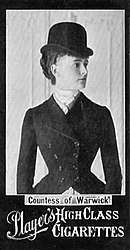
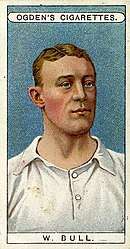

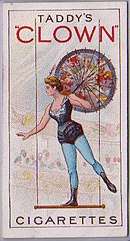
Beginning in 1875, cards depicting actresses, baseball players, Indian chiefs, boxers, national flags or wild animals were issued by the U.S.-based Allen & Ginter tobacco company. These are considered to be some of the first cigarette cards.[2] Other tobacco companies such as Goodwin & Co. soon followed suit. They first emerged in the U.S., then the UK, then, eventually, in many other countries.
In the UK, W.D. & H.O. Wills in 1887 were one of the first companies to include advertising cards with their cigarettes, but it was John Player & Sons in 1893 that produced one of the first general interest sets 'Castles and Abbeys'.
Thomas Ogden soon followed in 1894 and in 1895, Wills produced their first set 'Ships and Sailors', followed by 'Cricketers' in 1896. In 1906, Ogden's produced a set of association football cards depicting footballers in their club colours, in one of the first full-colour sets.
Each set of cards typically consisted of 25 or 50 related subjects, but series of over 100 cards per issue are known. Popular themes were 'beauties' (famous actresses, film stars and models), sporters (in the U.S. mainly baseball, in the rest of the world mainly football and cricket), nature, military heroes and uniforms, heraldry[3] and city views.
Imperial Tobacco Canada manufactured the first ice hockey cards ever for the inaugural NHL season. There were a total of 36 cards in the set, each one featured an illustration of a player.[4] After World War I, only one more cigarette set was issued, during the 1924–25
Today, for example, sports and military historians study these cards for details on uniform design.[5]
Some very early cigarette cards were printed on silk which was then attached to a paper backing. They were discontinued in order to save paper during World War II, and never fully reintroduced thereafter.
Doral, an R. J. Reynolds Tobacco Company brand, started printing cigarette cards in the year 2000. These were the first cigarette cards from a major manufacturer since the 1940s.,[6] although the small company Carreras in the UK issued cigarette cards with Turf brand cigarettes for a short period in the 1950s and 1960s, Black Cat brand in 1976.[7][8] Furthermore, card-like coupons with special offers have often been included in cigarette packets over the years.
The first set of "Doral Celebrate America" cards featured the 50 states in two releases, 2000 and 2001. Later themes include American festivals, cars, national parks, and 20th century events.
Natural American Spirit, another R.J. Reynolds Tobacco Company brand, also includes cigarette cards on their packs, with information on such things as windpower, diversity, and their farmers.
Philip Morris USA started including "Information For Smokers" cigarette cards in certain packs. One provides information on quitting smoking and the other states that "Light, "Ultra Light", "Mild", "Medium", and "Low Tar" cigarettes are just as harmful as "Full Flavor" ones.
World record price
The most valuable cigarette card in the world features Honus Wagner, one of the great names in U.S. baseball at the turn of the 20th century. The T206 Honus Wagner has repeatedly set records at auction, most recently in 2016 when it sold for $3,120,000.[9] Wagner was a dedicated non-smoker and objected when America's biggest tobacco corporation planned to picture him on a cigarette card without his permission.[10] Threats of legal action prevented its release, but a few slipped out, and it was one of these that stunned the collecting world when it was auctioned.
Other cigarette cards
Another notable and sought-after set of cards is the untitled series issued by Taddy and known by collectors as "Clowns and Circus Artistes". While not the rarest cards in existence (there are a number of series in which only one known example remains), they are still very rare and command high prices whenever they come up for auction.
The Mecca cigarette trading card for George Sutton is also notable for it depicts him with hands. Sutton was known as "the handless billiard player"[11] for mastering the game with such a handicap.
Classification and Cataloguing
The system devised to codify 19th Century American tobacco issues has its origin in the 'American Card Catalog' (ACC), written by Jefferson Burdick. Burdick listed the American Tobacco cards in one section, broken down by companies that issued the card series and by the types of cards. The 19th Century issues were prefixed with 'N' (N1-N694) and the 20th with 'T'. (T1-T235).[12]
The World Tobacco Index (WTI)
The World Tobacco Index (WTI), published by the Cartophilic Society of Great Britain (CSGB),[13] lists all known tobacco issues from around the world and is still being updated today on reports of new finds. Using a similar alphanumeric system, it assigns a code based on the name of manufacturer, rather than the century in which the cards were issued. For example, Burdick's N2 'Celebrated American Indian Chiefs' by Allen & Ginter is listed as A400-030 (a), with the larger N42 series listed as A400-030 (b).[14]
LCCC - Cigarette Card Catalogue
The catalogue contains details of cigarette cards and silks issued at home and abroad from the 19th century to the present day, quoting up-to-date values for cards in top condition. The original price guide now in its 84th year of publication. The catalogue has reference numbers to cross-reference with the British Tobacco Issues Handbook, Ogdens, G Phillips and Wills reference books giving information for British Tobacco series which will be a great help to collectors to identify cards especially unnumbered or untitled series.[15]
LCCC - Trade Card Catalogue
The catalogue gives an up-to-date price guide for odd cards, sets and special albums. First published in 1974, this catalogue is devoted entirely to non-tobacco cards plus a section, which details over 350 reprinted series. The catalogue covers a magnificent selection of well over 6,000 series by non-tobacco firms, such as Brooke Bond Tea, Bassett, A & BC Gum, Topps, as well as the newer companies like Rittenhouse, Inkworks, Golden Era, Rockwell, Hunter etc. Cards from the early 1900s by Fry and Cadbury right up to the latest series of Harry Potter, Star Wars TV & Films, Cricket, Footballers, Military, Motoring etc.[16]
As well as the series title and manufacturer, cards may also exhibit different back varieties to advertise the different brands of cigarette produced by a firm. For example, the English manufacturer Edwards, Ringer and Bigg's 1917 'War Map of the Western Front' was issued with both 'Exmoor Hunt' and 'New York Mixture' tobacco advertised on the backs. Whilst this was commonplace, the number of varieties varies greatly between manufacturers; F. & J. Smith's 1913 series entitled 'Battlefields of Great Britain' for example has 15 different backs.
Legacy
The largest cigarette card collection on record is that of Edward Wharton-Tigar. His collection, bequeathed to the British Museum following his death in 1995, is recognised by the Guinness Book of Records as the largest collection of its kind. His autobiography, "Burning Bright", details both his obsession with collecting cigarette cards, as well as his business life, which included becoming President of Selection Trust – at the time, one of the largest mining companies in the world – as well as his lifelong passion for cricket, which culminated in his presidency of Kent Cricket Club. When asked what others thought of his collecting he said:
If to collect cigarette cards is a sign of eccentricity, how then will posterity judge one who amassed the biggest collection in the world? Frankly, I care not.[17]
He was the president of the Cartophilic Society of Great Britain until his death in 1995.
Gallery
 Actress Georgia Cayvan, c. 1882
Actress Georgia Cayvan, c. 1882 Bill East, English oarsman, c. 1885
Bill East, English oarsman, c. 1885 King Kelly (Goodwin & Company Cigarettes 1888)
King Kelly (Goodwin & Company Cigarettes 1888) Maurice Daly, US billiards champion, 1888
Maurice Daly, US billiards champion, 1888_for_Allen_%26_Ginter_Cigarettes_Brands_MET_DP828039.jpg) Chief Gall (Allen & Ginter, 1888)
Chief Gall (Allen & Ginter, 1888) Amy Coleridge, before 1900
Amy Coleridge, before 1900 Actress, Blanche Bates, 1901
Actress, Blanche Bates, 1901 Former Australian cricket captain, Joe Darling, early 1900s
Former Australian cricket captain, Joe Darling, early 1900s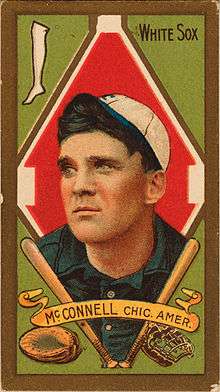 Ambrose McConnell (American Tobacco, 1911)
Ambrose McConnell (American Tobacco, 1911) Reformer A.C. of Argentina, Cigarrillos Monterrey, 1911
Reformer A.C. of Argentina, Cigarrillos Monterrey, 1911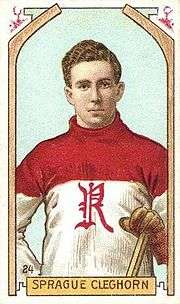 Sprague Cleghorn (Imperial Tobacco, c. 1911–12)
Sprague Cleghorn (Imperial Tobacco, c. 1911–12) How to Hold Pets (Ogden's Cigarettes 1903–1917)
How to Hold Pets (Ogden's Cigarettes 1903–1917) Boy Scout (Ogden's Cigarettes 1903–1917)
Boy Scout (Ogden's Cigarettes 1903–1917)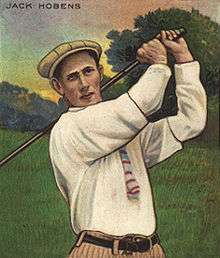 A 1910 artist's rendition of Jack Hobens (Mecca cigarettes)
A 1910 artist's rendition of Jack Hobens (Mecca cigarettes)- A 1910 card showing pro golfer George Low, Sr. (Mecca cigarettes)
 Victoria Cross recipient Alexander Stewart Burton, c. 1915 (Gallaher Cigarettes)
Victoria Cross recipient Alexander Stewart Burton, c. 1915 (Gallaher Cigarettes)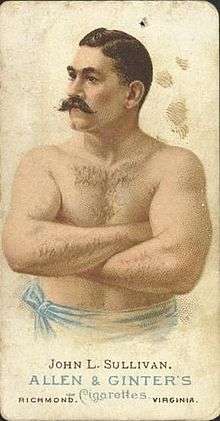 John L. Sullivan (Allen & Ginter's Cigarettes), 1888-1889
John L. Sullivan (Allen & Ginter's Cigarettes), 1888-1889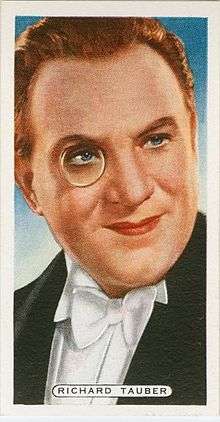 Richard Tauber, Film, stage and radio stars (1932)
Richard Tauber, Film, stage and radio stars (1932)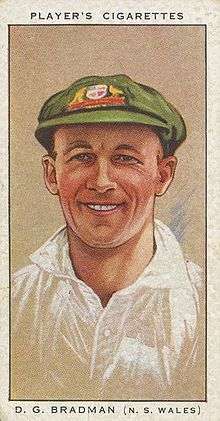 Australian batsman, Donald Bradman on a cigarette card distributed during the 1934 Ashes series
Australian batsman, Donald Bradman on a cigarette card distributed during the 1934 Ashes series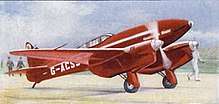 de Havilland Comet (Player's Cigarettes 1935)
de Havilland Comet (Player's Cigarettes 1935) George H. Sutton (Mecca cigarettes)
George H. Sutton (Mecca cigarettes) Tommy Weston, Champion Jockey 1926, by Gallaher Cigarettes 1936
Tommy Weston, Champion Jockey 1926, by Gallaher Cigarettes 1936 Lord Lonsdale's racing colours by E & W Anstie 1922
Lord Lonsdale's racing colours by E & W Anstie 1922
See also
References
- W. Duke, Sons & Co. Advertising Materials, 1880-1910 on Duke University Digital Library
- Shaw, James A. "Allen & Ginter's champions". Archived from the original on 2006-04-05. Retrieved 2006-06-21.
- Heraldic cigarette and tobacco cards
- History of Hockey Cards on Starr Cards website
- Backcheck: A Hockey Retrospective Archived 2007-10-01 at the Wayback Machine at Library and Archives Canada
- "Doral Revives Collector Cards with Purchase". Brandweek. 2001-01-15. Archived from the original on 2005-07-19. Retrieved 2006-06-21.
- Franklyn Cards: A brief history of cigarette cards Archived March 22, 2007, at the Wayback Machine
- Catalogues, for example: Murray Cards (International). Catalogue of Cigarette & Other Trade Cards. 3.ed. (1981)
- Cracknell, Ryan. "World Record $3.12 Million for T206 Honus Wagner Baseball Card". Beckett. Retrieved 21 March 2020.
- Davis, Ralph S. (1912-10-12). "Wagner A Wonder: One Player In Game Who Is Not Money Mad" (PDF). The Sporting News. Archived from the original (PDF) on 2007-10-09. Retrieved 2007-10-19.
- "Sutton plays fine billiards; Handless Player's Remarkable Work Against Expert Thomas Gallagher. New York Times". The New York Times. 1903-03-17.
- Forbes, R and Mitchell, T, (1999) 'American Tobacco Cards: Price Guide and Checklist', Virginia: Tuff Stuff Books
- The Cartophilic Society of Great Britain (2000) 'The (New) World Tobacco Issues Index: Part 1', London: The Cartophilic Society of Gt. Britain Ltd.
- "Cartophilic Society (CSGB)". Archived from the original on 2002-10-22. Retrieved 2002-10-22.
- Cigarette Card Catalogue
- Trade Card Catalogue on London Cigarette Card Co.
- Wharton-Tigar, E. (1987) 'Burning Bright: The Autobiography of Edward Wharton-Tigar' London: Metal Bulletin Books, p.254
External links
| Wikimedia Commons has media related to Cigarette cards. |
- Leonard Brecher Tobacco & Chewing Gum Card Collection at the University of Louisville Art Library
- Cigarette and Trade Card Valuation
- Cigarette Cards: ABCs, at the New York Public Library Digital Gallery
- Catalogue of heraldic tobacco and trading cards
- Duke Tobacco Company Cigarette Cards, at the Z. Smith Reynolds Library, Wake Forest University
- The London Cigarette Card Co. Ltd The London Cigarette Card Co. Ltd - Valuing & selling cigarette cards. The UK's largest supplier of cigarette, collectors and baseball cards.
- The Cartophilic Society of Great Britain
